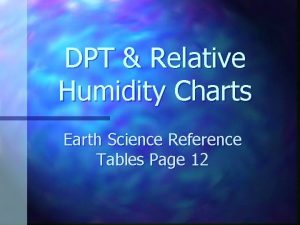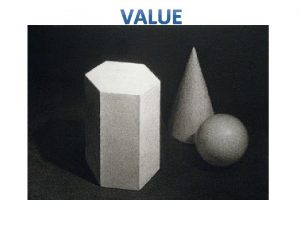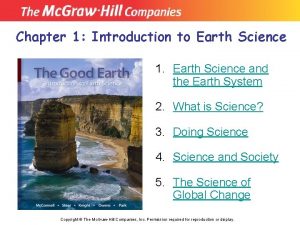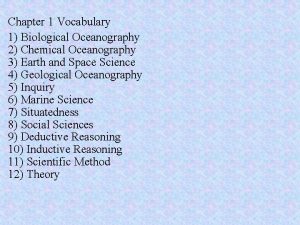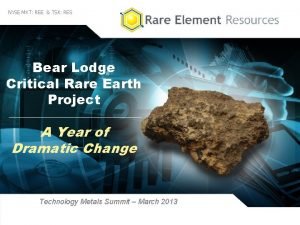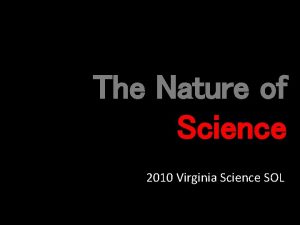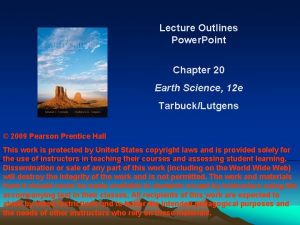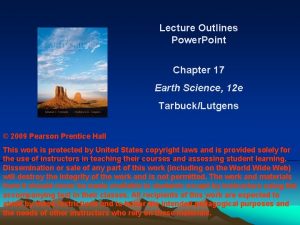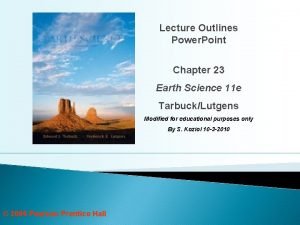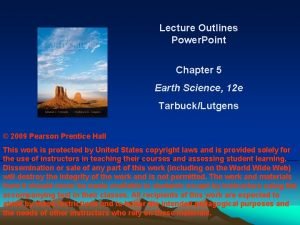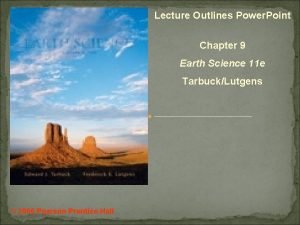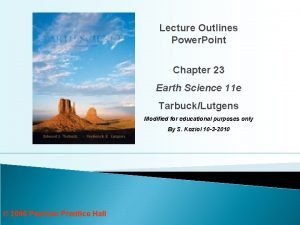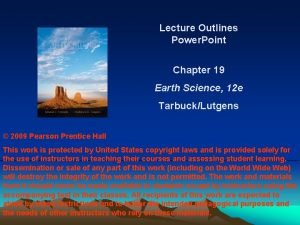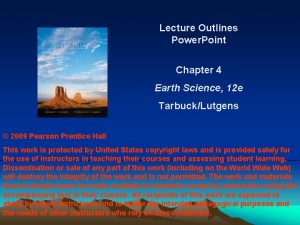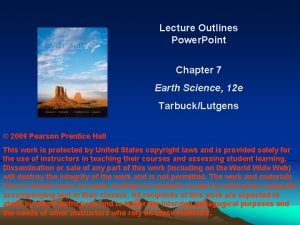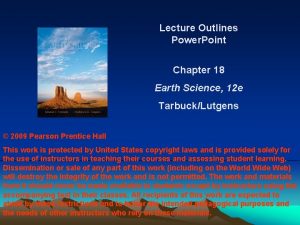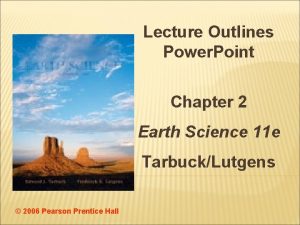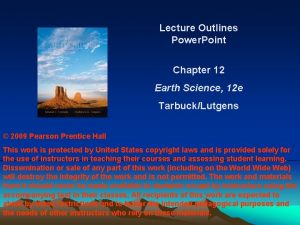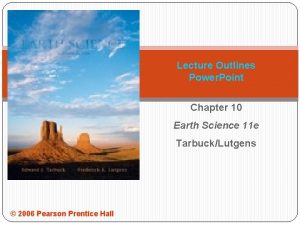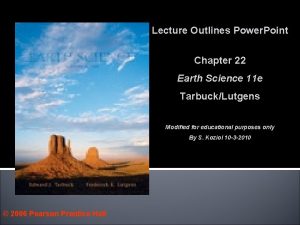Lecture Outlines Power Point Chapter 21 Earth Science












































- Slides: 44

Lecture Outlines Power. Point Chapter 21 Earth Science 11 e Tarbuck/Lutgens Modified by S. Koziol 10 -3 -2010 For educational purposes only © 2006 Pearson Prentice Hall

Earth Science, 11 e Origin of Modern Astronomy Chapter 21

Early history of astronomy v. Ancient Greeks • Used philosophical arguments to explain natural phenomena • Also used some observational data • Most ancient Greeks held a geocentric (Earth-centered) view of the universe • "Earth-centered" view • Earth was a motionless sphere at the center of the universe

Early history of astronomy v. Ancient Greeks • Most ancient Greeks held a geocentric (Earth-centered) view of the universe • "Earth-centered" view • Stars were on the celestial sphere • Transparent, hollow sphere • Celestial sphere turns daily around Earth

Early history of astronomy v. Ancient Greeks • Most ancient Greeks held a geocentric (Earthcentered) view of the universe • Seven heavenly bodies (planetai) • Changed position in sky • The seven wanderers included the • Sun • Moon • Mercury through Saturn (excluding Earth)

Early history of astronomy v. Ancient Greeks • Aristarchus (312 -230 B. C. ) was the first Greek to profess a Sun-centered, or heliocentric, universe • Planets exhibit an apparent westward drift • Called retrograde motion • Occurs as Earth, with its faster orbital speed, overtakes another planet

Early history of astronomy v. Ancient Greeks (continued) • Aristotle (384 -322 B. C. ) concluded that Earth is spherical • Eratosthenes (276 -194 B. C. ) established the size of the Earth • Hipparchus (second century B. C. ) was best known for his star catalog. • Anaxagoras (fifth century B. C. ) reasoned that the Moon shines by reflected sunlight, and because it is a sphere, only ½ is illuminated at once.

Early history of astronomy v. Ancient Greeks • Ptolemaic system • A. D. 141 • Geocentric model • To explain retrograde motion, Ptolemy used two motions for the planets • Large orbital circles, called deferents, and • Small circles, called epicycles

The universe according to Ptolemy, second century A. D. Figure 21. 4 A

Retrograde motion as explained by Ptolemy Figure 21. 4 B

Retrograde Motion Retrograde motion is the movement of a planet in an opposing direction across the sky.

Mars Retrograde

Quiz Break

Early history of astronomy v. Birth of modern astronomy • 1500 s and 1600 s • Five noted scientists • Nicolaus Copernicus (1473 -1543) • Concluded Earth was a planet • Constructed a model of the solar system that put the Sun at the center, but he used circular orbits for the planets • Ushered out old astronomy

Early history of astronomy v. Birth of modern astronomy • Five noted scientists • Tycho Brahe (1546 -1601) • Precise observer • Tried to find stellar parallax – the apparent shift in a star's position due to the revolution of Earth • Did not believe in the Copernican system because he was unable to observe stellar parallax

Early history of astronomy v. Birth of modern astronomy • Five noted scientists • Johannes Kepler (1571 -1630) • Ushered in new astronomy • Planets revolve around the Sun • Three laws of planetary motion • Orbits of the planets are elliptical • Planets revolve around the Sun at varying speed

Kepler’s law of equal areas Figure 21. 10

Early history of astronomy v. Birth of modern astronomy • Five noted scientists • Johannes Kepler (1571 -1630) • Three laws of planetary motion • There is a proportional relation between a planet's orbital period and its distance to the Sun (measured in astronomical units (AU’s) – one AU averages about 150 million kilometers, or 93 million miles)

Early history of astronomy v. Birth of modern astronomy • Five noted scientists • Galileo Galilei (1564 -1642) • Supported Copernican theory • Used experimental data • Constructed an astronomical telescope in 1609 • Four large moons of Jupiter • Planets appeared as disks • Phases of Venus • Features on the Moon • Sunspots

Early history of astronomy v. Birth of modern astronomy • Five noted scientists • Sir Isaac Newton (1643 -1727) • Law of universal gravitation • Proved that the force of gravity, combined with the tendency of a planet to remain in straight-line motion, results in the elliptical orbits discovered by Kepler

Constellations v Configuration of stars named in honor of mythological characters or great heroes v Today 88 constellations are recognized v Constellations divide the sky into units, like state boundaries in the United States v The brightest stars in a constellation are identified in order of their brightness by the letters of the Greek alphabet – alpha, beta, and so on

Quiz Break

Positions in the sky v. Stars appear to be fixed on a spherical shell (the celestial sphere) that surrounds Earth v. Equatorial system of location • A coordinate system that divides the celestial sphere • Similar to the latitude-longitude system that is used on Earth's surface • Two locational components • Declination – the angular distance north or south of the celestial equator

Positions in the sky v. Equatorial system of location • Two locational components • Right ascension – the angular distance measured eastward along the celestial equator from the position of the vernal equinox

Astronomical coordinate system on the celestial sphere Figure 21. 16

Earth motions v. Two primary motions • Rotation • Turning, or spinning, of a body on its axis • Two measurements for rotation • Mean solar day – the time interval from one noon to the next, about 24 hours • Sidereal day – the time it takes for Earth to make one complete rotation (360º) with respect to a star other than the Sun – 23 hours, 56 minutes, 4 seconds

The difference between a solar day and a sidereal day Figure 21. 19

Earth motions v. Two primary motions • Revolution • The motion of a body, such as a planet or moon, along a path around some point in space • Earth's orbit is elliptical • Earth is closest to the Sun (perihelion) in January • Earth is farthest from the Sun (aphelion) in July • The plane of the ecliptic is an imaginary plane that connects Earth's orbit with the celestial sphere

Earth motions v. Other Earth motions • Precession • Very slow Earth movement • Direction in which Earth's axis points continually changes • Movement with the solar system in the direction of the star Vega • Revolution with the Sun around the galaxy • Movement with the galaxy within the universe

Precession of Earth Figure 21. 22

Quiz Break

Motions of the Earth-Moon system v. Phases of the Moon • When viewed from above the North Pole, the Moon orbits Earth in a counterclockwise (eastward) direction • The relative positions of the Sun, Earth, and Moon constantly change • Lunar phases are a consequence of the motion of the Moon and the sunlight that is reflected from its surface

Phases of the Moon Figure 21. 23

Motions of the Earth-Moon system v. Lunar motions • Earth-Moon • Synodic month • Cycle of the phases • Takes 29 1/2 days • Sidereal month • True period of the Moon's revolution around Earth • Takes 27 1/3 days

The difference between the sidereal month and the synodic month Figure 21. 24

Motions of the Earth-Moon system v. Lunar motions • Earth-Moon • The difference of two days between the synodic and sidereal cycles is due to the Earth-Moon system also moving in an orbit around the Sun • Moon's period of rotation about its axis and its revolution around Earth are the same, 27 1/3 days • Causes the same lunar hemisphere to always face Earth

Motions of the Earth-Moon system v Eclipses • Simply shadow effects that were first understood by the early Greeks • Two types of eclipses • Solar eclipse • Moon moves in a line directly between Earth and the Sun • Can only occur during the new-Moon phase

Solar eclipse Figure 21. 25

Motions of the Earth-Moon system v Eclipses • Two types of eclipses • Lunar eclipse • Moon moves within the shadow of Earth • Only occurs during the full-Moon phase • For any eclipse to take place, the Moon must be in the plane of the ecliptic at the time of new- or full-Moon

Motions of the Earth-Moon system v. Eclipses • Two types of eclipses • Lunar eclipse • Because the Moon's orbit is inclined about 5 degrees to the plane of the ecliptic, during most of the times of new- and full-Moon the Moon is above or below the plane, and no eclipse can occur • The usual number of eclipses is four per year

Lunar eclipse Figure 21. 26

Quiz Break

Theories, Facts, Laws, Beliefs, and Hypotheses ? • P 2= a 3 • The Earth is an oblate spheroid. • More babies are born, and crime takes place, during the time of the full Moon. • The Earth, and our solar system are older than 10, 000 years. • Newton’s Laws of motion explain why orbits are ellipses.

End of Chapter 21
 Relative humidity reference table
Relative humidity reference table 01:640:244 lecture notes - lecture 15: plat, idah, farad
01:640:244 lecture notes - lecture 15: plat, idah, farad Power triangle
Power triangle Informsu
Informsu My favourite subject english
My favourite subject english Point point power
Point point power What is an outline? *
What is an outline? * Teaching outline
Teaching outline Kairos talk outlines
Kairos talk outlines Commercial law outlines
Commercial law outlines Four main components for effective outlines
Four main components for effective outlines A business plan is a document that outlines
A business plan is a document that outlines Benign nephrosclerosis pathology outlines
Benign nephrosclerosis pathology outlines 2 kings 4 8 17 sermon
2 kings 4 8 17 sermon Anime outline
Anime outline Two types of outlines
Two types of outlines A haunted house virginia woolf analysis
A haunted house virginia woolf analysis Ksf outlines
Ksf outlines Mucoepidermoid carcinoma histology
Mucoepidermoid carcinoma histology Cmmi model outlines
Cmmi model outlines Sermon outlines on ananias and sapphira
Sermon outlines on ananias and sapphira Exegetical outline
Exegetical outline Cjis level 4 certification
Cjis level 4 certification Mun position paper outline
Mun position paper outline Define:visible
Define:visible Focal crypt abscess
Focal crypt abscess A clear concise document which outlines preventive
A clear concise document which outlines preventive Chapter 1 introduction to earth science
Chapter 1 introduction to earth science Earth science chapter 1 vocabulary
Earth science chapter 1 vocabulary Power system dynamics and stability lecture notes
Power system dynamics and stability lecture notes Zline 667-36
Zline 667-36 Power semiconductor devices lecture notes
Power semiconductor devices lecture notes Switch mode power supply lecture notes
Switch mode power supply lecture notes Power system dynamics and stability lecture notes
Power system dynamics and stability lecture notes Physical science lecture notes
Physical science lecture notes Things fall apart customs
Things fall apart customs What height of love what depth of peace
What height of love what depth of peace Treo tsx
Treo tsx Where do polar and tropical air masses develop
Where do polar and tropical air masses develop Earth science sol 2010
Earth science sol 2010 Earth science regents lab practical review
Earth science regents lab practical review Part d earth science regents
Part d earth science regents Earth science lab practical
Earth science lab practical Earth science grade 9
Earth science grade 9 Dynamic equilibrium earth science
Dynamic equilibrium earth science
